Improving Dementia Patient Health: Excel Care Safeguarding Analysis
VerifiedAdded on 2023/01/09
|35
|9510
|69
Report
AI Summary
This report examines the critical topic of safeguarding service users with dementia within care home settings, utilizing a case study approach focusing on Excel Care. The introduction provides an overview of the research, its background, aims, and objectives, laying the groundwork for a comprehensive investigation into the challenges and strategies related to dementia care. The literature review delves into the fundamental understanding of dementia, exploring its causes, symptoms, and various types, followed by an analysis of the reasons behind safeguarding dementia patients, highlighting their vulnerability and the importance of protecting their rights and well-being. The report further investigates effective safeguarding methods, including practical approaches used by care providers, while also addressing the issues faced by caregivers, such as patient abuse and difficulties in treatment adherence. The research methodology outlines the research design, data collection methods, and ethical considerations, providing a framework for the data analysis. The data analysis section interprets the findings, offering insights into the challenges and successes of safeguarding practices. Finally, the report concludes with recommendations for improving safeguarding strategies and a reflection on the research process, offering valuable insights for healthcare professionals and policymakers aiming to enhance the quality of care for individuals with dementia.

Improving the Health of
Others through Effective
Research
Others through Effective
Research
Paraphrase This Document
Need a fresh take? Get an instant paraphrase of this document with our AI Paraphraser
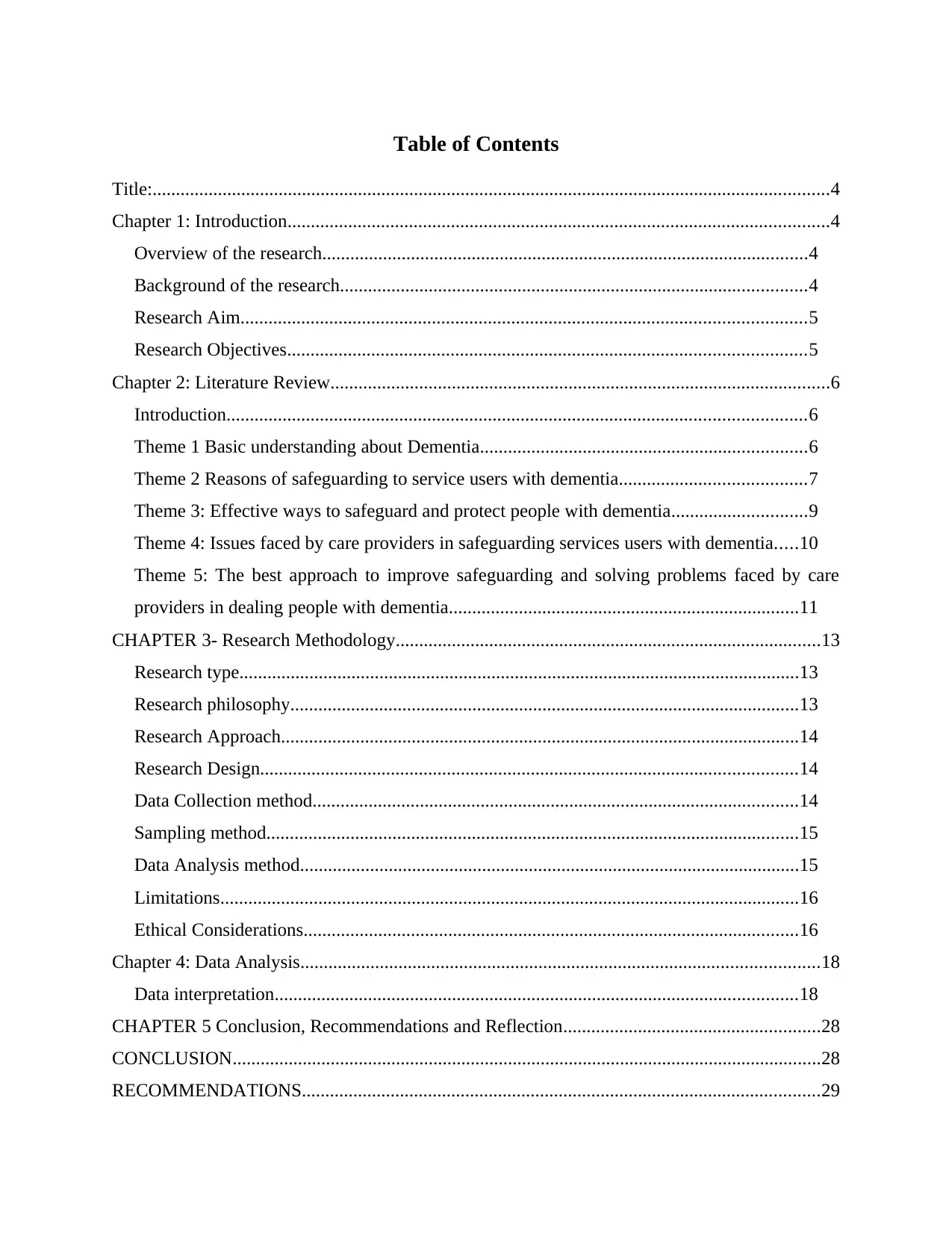
Table of Contents
Title:.................................................................................................................................................4
Chapter 1: Introduction....................................................................................................................4
Overview of the research........................................................................................................4
Background of the research....................................................................................................4
Research Aim.........................................................................................................................5
Research Objectives...............................................................................................................5
Chapter 2: Literature Review...........................................................................................................6
Introduction............................................................................................................................6
Theme 1 Basic understanding about Dementia......................................................................6
Theme 2 Reasons of safeguarding to service users with dementia........................................7
Theme 3: Effective ways to safeguard and protect people with dementia.............................9
Theme 4: Issues faced by care providers in safeguarding services users with dementia.....10
Theme 5: The best approach to improve safeguarding and solving problems faced by care
providers in dealing people with dementia...........................................................................11
CHAPTER 3- Research Methodology...........................................................................................13
Research type........................................................................................................................13
Research philosophy.............................................................................................................13
Research Approach...............................................................................................................14
Research Design...................................................................................................................14
Data Collection method........................................................................................................14
Sampling method..................................................................................................................15
Data Analysis method...........................................................................................................15
Limitations............................................................................................................................16
Ethical Considerations..........................................................................................................16
Chapter 4: Data Analysis...............................................................................................................18
Data interpretation................................................................................................................18
CHAPTER 5 Conclusion, Recommendations and Reflection.......................................................28
CONCLUSION..............................................................................................................................28
RECOMMENDATIONS...............................................................................................................29
Title:.................................................................................................................................................4
Chapter 1: Introduction....................................................................................................................4
Overview of the research........................................................................................................4
Background of the research....................................................................................................4
Research Aim.........................................................................................................................5
Research Objectives...............................................................................................................5
Chapter 2: Literature Review...........................................................................................................6
Introduction............................................................................................................................6
Theme 1 Basic understanding about Dementia......................................................................6
Theme 2 Reasons of safeguarding to service users with dementia........................................7
Theme 3: Effective ways to safeguard and protect people with dementia.............................9
Theme 4: Issues faced by care providers in safeguarding services users with dementia.....10
Theme 5: The best approach to improve safeguarding and solving problems faced by care
providers in dealing people with dementia...........................................................................11
CHAPTER 3- Research Methodology...........................................................................................13
Research type........................................................................................................................13
Research philosophy.............................................................................................................13
Research Approach...............................................................................................................14
Research Design...................................................................................................................14
Data Collection method........................................................................................................14
Sampling method..................................................................................................................15
Data Analysis method...........................................................................................................15
Limitations............................................................................................................................16
Ethical Considerations..........................................................................................................16
Chapter 4: Data Analysis...............................................................................................................18
Data interpretation................................................................................................................18
CHAPTER 5 Conclusion, Recommendations and Reflection.......................................................28
CONCLUSION..............................................................................................................................28
RECOMMENDATIONS...............................................................................................................29

REFLECTION...............................................................................................................................30
References......................................................................................................................................31
Appendix........................................................................................................................................33
References......................................................................................................................................31
Appendix........................................................................................................................................33
⊘ This is a preview!⊘
Do you want full access?
Subscribe today to unlock all pages.

Trusted by 1+ million students worldwide
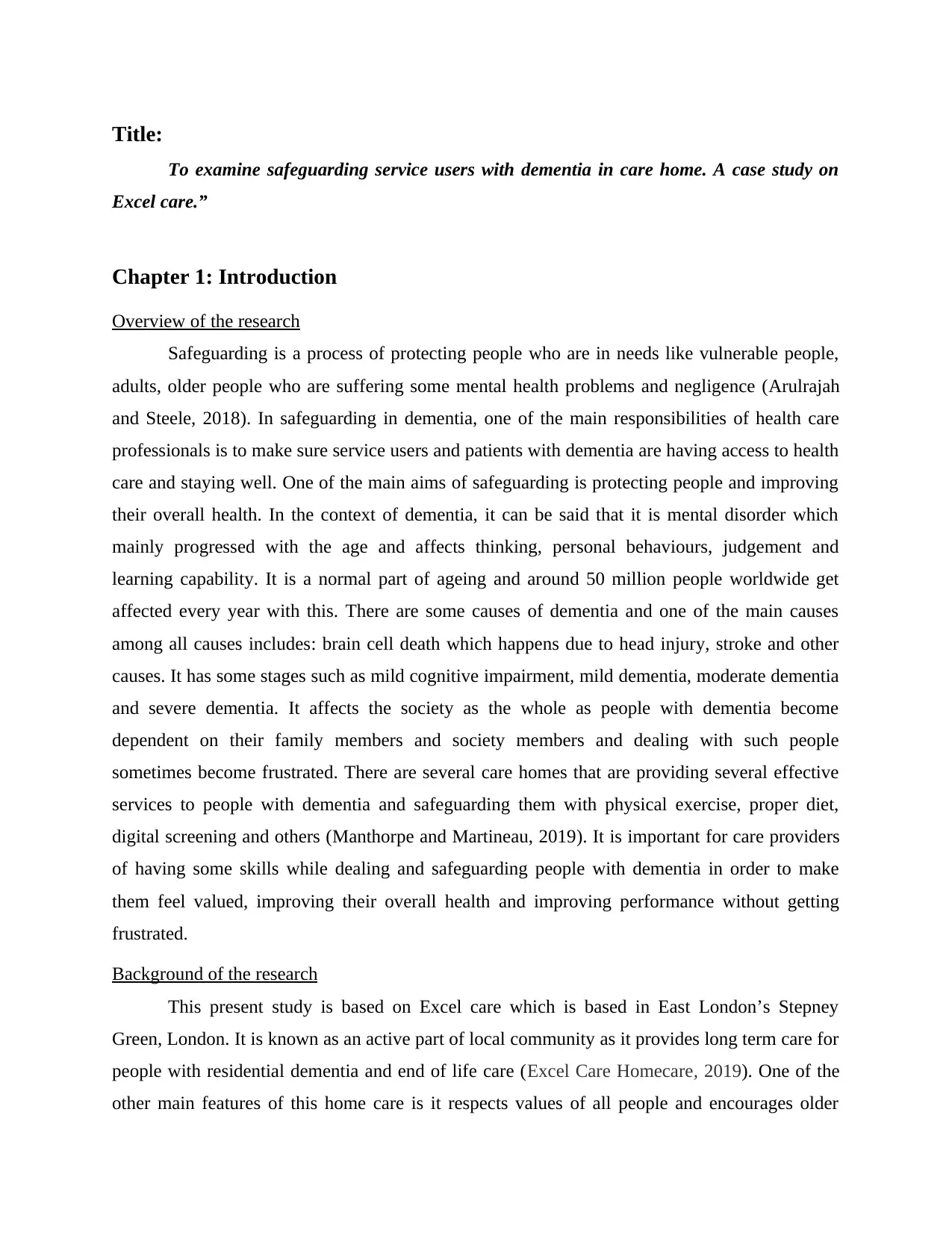
Title:
To examine safeguarding service users with dementia in care home. A case study on
Excel care.”
Chapter 1: Introduction
Overview of the research
Safeguarding is a process of protecting people who are in needs like vulnerable people,
adults, older people who are suffering some mental health problems and negligence (Arulrajah
and Steele, 2018). In safeguarding in dementia, one of the main responsibilities of health care
professionals is to make sure service users and patients with dementia are having access to health
care and staying well. One of the main aims of safeguarding is protecting people and improving
their overall health. In the context of dementia, it can be said that it is mental disorder which
mainly progressed with the age and affects thinking, personal behaviours, judgement and
learning capability. It is a normal part of ageing and around 50 million people worldwide get
affected every year with this. There are some causes of dementia and one of the main causes
among all causes includes: brain cell death which happens due to head injury, stroke and other
causes. It has some stages such as mild cognitive impairment, mild dementia, moderate dementia
and severe dementia. It affects the society as the whole as people with dementia become
dependent on their family members and society members and dealing with such people
sometimes become frustrated. There are several care homes that are providing several effective
services to people with dementia and safeguarding them with physical exercise, proper diet,
digital screening and others (Manthorpe and Martineau, 2019). It is important for care providers
of having some skills while dealing and safeguarding people with dementia in order to make
them feel valued, improving their overall health and improving performance without getting
frustrated.
Background of the research
This present study is based on Excel care which is based in East London’s Stepney
Green, London. It is known as an active part of local community as it provides long term care for
people with residential dementia and end of life care (Excel Care Homecare, 2019). One of the
other main features of this home care is it respects values of all people and encourages older
To examine safeguarding service users with dementia in care home. A case study on
Excel care.”
Chapter 1: Introduction
Overview of the research
Safeguarding is a process of protecting people who are in needs like vulnerable people,
adults, older people who are suffering some mental health problems and negligence (Arulrajah
and Steele, 2018). In safeguarding in dementia, one of the main responsibilities of health care
professionals is to make sure service users and patients with dementia are having access to health
care and staying well. One of the main aims of safeguarding is protecting people and improving
their overall health. In the context of dementia, it can be said that it is mental disorder which
mainly progressed with the age and affects thinking, personal behaviours, judgement and
learning capability. It is a normal part of ageing and around 50 million people worldwide get
affected every year with this. There are some causes of dementia and one of the main causes
among all causes includes: brain cell death which happens due to head injury, stroke and other
causes. It has some stages such as mild cognitive impairment, mild dementia, moderate dementia
and severe dementia. It affects the society as the whole as people with dementia become
dependent on their family members and society members and dealing with such people
sometimes become frustrated. There are several care homes that are providing several effective
services to people with dementia and safeguarding them with physical exercise, proper diet,
digital screening and others (Manthorpe and Martineau, 2019). It is important for care providers
of having some skills while dealing and safeguarding people with dementia in order to make
them feel valued, improving their overall health and improving performance without getting
frustrated.
Background of the research
This present study is based on Excel care which is based in East London’s Stepney
Green, London. It is known as an active part of local community as it provides long term care for
people with residential dementia and end of life care (Excel Care Homecare, 2019). One of the
other main features of this home care is it respects values of all people and encourages older
Paraphrase This Document
Need a fresh take? Get an instant paraphrase of this document with our AI Paraphraser
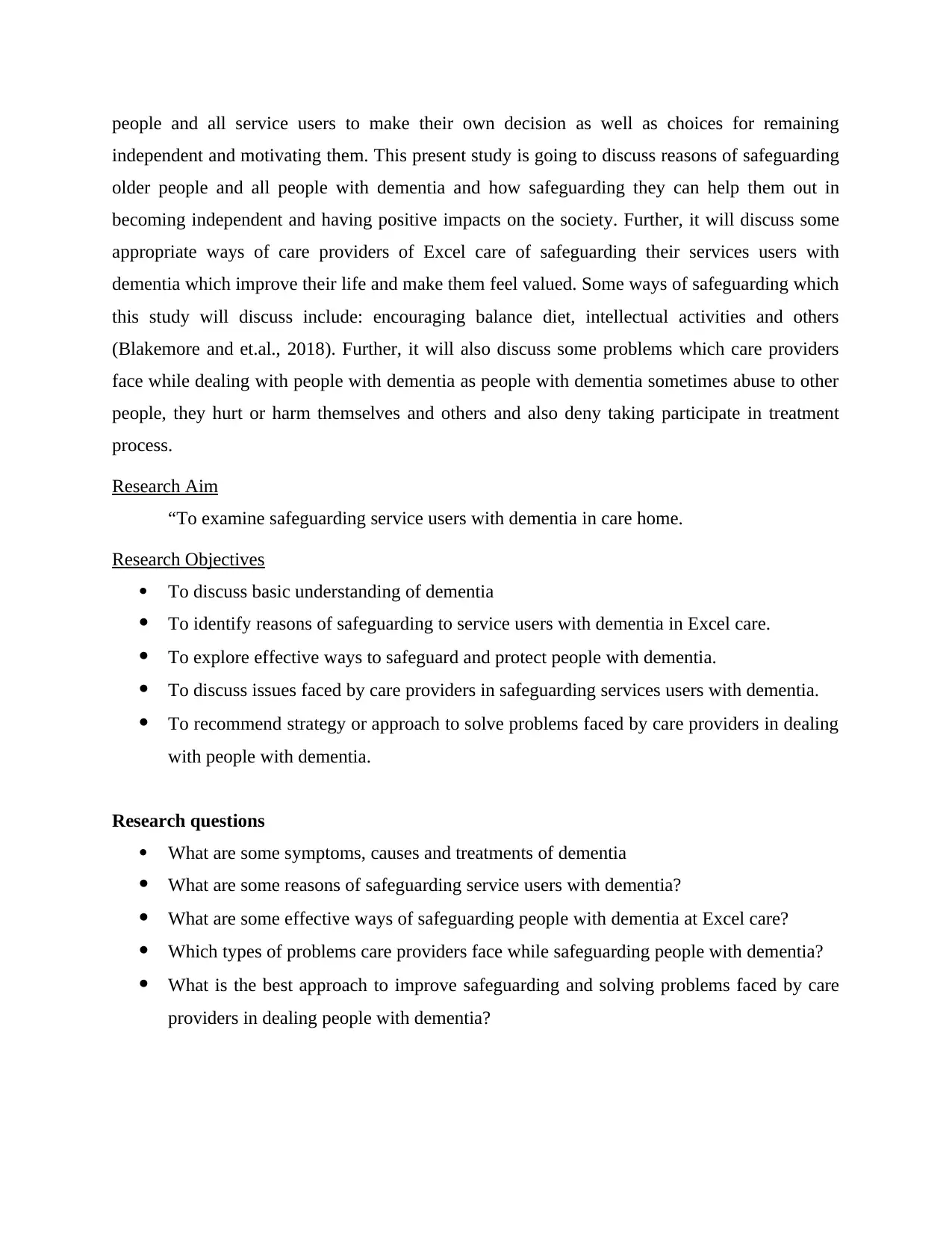
people and all service users to make their own decision as well as choices for remaining
independent and motivating them. This present study is going to discuss reasons of safeguarding
older people and all people with dementia and how safeguarding they can help them out in
becoming independent and having positive impacts on the society. Further, it will discuss some
appropriate ways of care providers of Excel care of safeguarding their services users with
dementia which improve their life and make them feel valued. Some ways of safeguarding which
this study will discuss include: encouraging balance diet, intellectual activities and others
(Blakemore and et.al., 2018). Further, it will also discuss some problems which care providers
face while dealing with people with dementia as people with dementia sometimes abuse to other
people, they hurt or harm themselves and others and also deny taking participate in treatment
process.
Research Aim
“To examine safeguarding service users with dementia in care home.
Research Objectives
To discuss basic understanding of dementia
To identify reasons of safeguarding to service users with dementia in Excel care.
To explore effective ways to safeguard and protect people with dementia.
To discuss issues faced by care providers in safeguarding services users with dementia.
To recommend strategy or approach to solve problems faced by care providers in dealing
with people with dementia.
Research questions
What are some symptoms, causes and treatments of dementia
What are some reasons of safeguarding service users with dementia?
What are some effective ways of safeguarding people with dementia at Excel care?
Which types of problems care providers face while safeguarding people with dementia?
What is the best approach to improve safeguarding and solving problems faced by care
providers in dealing people with dementia?
independent and motivating them. This present study is going to discuss reasons of safeguarding
older people and all people with dementia and how safeguarding they can help them out in
becoming independent and having positive impacts on the society. Further, it will discuss some
appropriate ways of care providers of Excel care of safeguarding their services users with
dementia which improve their life and make them feel valued. Some ways of safeguarding which
this study will discuss include: encouraging balance diet, intellectual activities and others
(Blakemore and et.al., 2018). Further, it will also discuss some problems which care providers
face while dealing with people with dementia as people with dementia sometimes abuse to other
people, they hurt or harm themselves and others and also deny taking participate in treatment
process.
Research Aim
“To examine safeguarding service users with dementia in care home.
Research Objectives
To discuss basic understanding of dementia
To identify reasons of safeguarding to service users with dementia in Excel care.
To explore effective ways to safeguard and protect people with dementia.
To discuss issues faced by care providers in safeguarding services users with dementia.
To recommend strategy or approach to solve problems faced by care providers in dealing
with people with dementia.
Research questions
What are some symptoms, causes and treatments of dementia
What are some reasons of safeguarding service users with dementia?
What are some effective ways of safeguarding people with dementia at Excel care?
Which types of problems care providers face while safeguarding people with dementia?
What is the best approach to improve safeguarding and solving problems faced by care
providers in dealing people with dementia?
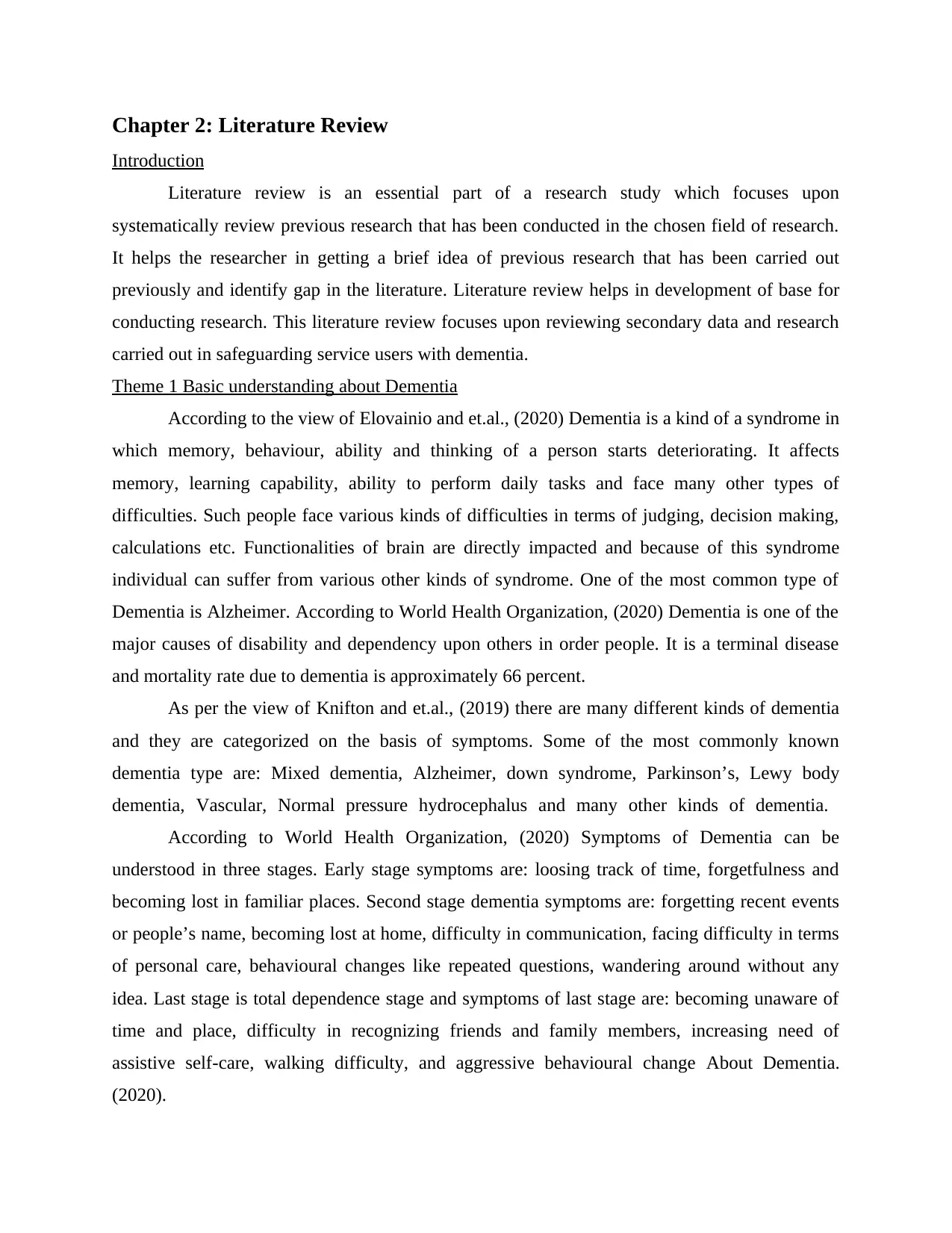
Chapter 2: Literature Review
Introduction
Literature review is an essential part of a research study which focuses upon
systematically review previous research that has been conducted in the chosen field of research.
It helps the researcher in getting a brief idea of previous research that has been carried out
previously and identify gap in the literature. Literature review helps in development of base for
conducting research. This literature review focuses upon reviewing secondary data and research
carried out in safeguarding service users with dementia.
Theme 1 Basic understanding about Dementia
According to the view of Elovainio and et.al., (2020) Dementia is a kind of a syndrome in
which memory, behaviour, ability and thinking of a person starts deteriorating. It affects
memory, learning capability, ability to perform daily tasks and face many other types of
difficulties. Such people face various kinds of difficulties in terms of judging, decision making,
calculations etc. Functionalities of brain are directly impacted and because of this syndrome
individual can suffer from various other kinds of syndrome. One of the most common type of
Dementia is Alzheimer. According to World Health Organization, (2020) Dementia is one of the
major causes of disability and dependency upon others in order people. It is a terminal disease
and mortality rate due to dementia is approximately 66 percent.
As per the view of Knifton and et.al., (2019) there are many different kinds of dementia
and they are categorized on the basis of symptoms. Some of the most commonly known
dementia type are: Mixed dementia, Alzheimer, down syndrome, Parkinson’s, Lewy body
dementia, Vascular, Normal pressure hydrocephalus and many other kinds of dementia.
According to World Health Organization, (2020) Symptoms of Dementia can be
understood in three stages. Early stage symptoms are: loosing track of time, forgetfulness and
becoming lost in familiar places. Second stage dementia symptoms are: forgetting recent events
or people’s name, becoming lost at home, difficulty in communication, facing difficulty in terms
of personal care, behavioural changes like repeated questions, wandering around without any
idea. Last stage is total dependence stage and symptoms of last stage are: becoming unaware of
time and place, difficulty in recognizing friends and family members, increasing need of
assistive self-care, walking difficulty, and aggressive behavioural change About Dementia.
(2020).
Introduction
Literature review is an essential part of a research study which focuses upon
systematically review previous research that has been conducted in the chosen field of research.
It helps the researcher in getting a brief idea of previous research that has been carried out
previously and identify gap in the literature. Literature review helps in development of base for
conducting research. This literature review focuses upon reviewing secondary data and research
carried out in safeguarding service users with dementia.
Theme 1 Basic understanding about Dementia
According to the view of Elovainio and et.al., (2020) Dementia is a kind of a syndrome in
which memory, behaviour, ability and thinking of a person starts deteriorating. It affects
memory, learning capability, ability to perform daily tasks and face many other types of
difficulties. Such people face various kinds of difficulties in terms of judging, decision making,
calculations etc. Functionalities of brain are directly impacted and because of this syndrome
individual can suffer from various other kinds of syndrome. One of the most common type of
Dementia is Alzheimer. According to World Health Organization, (2020) Dementia is one of the
major causes of disability and dependency upon others in order people. It is a terminal disease
and mortality rate due to dementia is approximately 66 percent.
As per the view of Knifton and et.al., (2019) there are many different kinds of dementia
and they are categorized on the basis of symptoms. Some of the most commonly known
dementia type are: Mixed dementia, Alzheimer, down syndrome, Parkinson’s, Lewy body
dementia, Vascular, Normal pressure hydrocephalus and many other kinds of dementia.
According to World Health Organization, (2020) Symptoms of Dementia can be
understood in three stages. Early stage symptoms are: loosing track of time, forgetfulness and
becoming lost in familiar places. Second stage dementia symptoms are: forgetting recent events
or people’s name, becoming lost at home, difficulty in communication, facing difficulty in terms
of personal care, behavioural changes like repeated questions, wandering around without any
idea. Last stage is total dependence stage and symptoms of last stage are: becoming unaware of
time and place, difficulty in recognizing friends and family members, increasing need of
assistive self-care, walking difficulty, and aggressive behavioural change About Dementia.
(2020).
⊘ This is a preview!⊘
Do you want full access?
Subscribe today to unlock all pages.

Trusted by 1+ million students worldwide
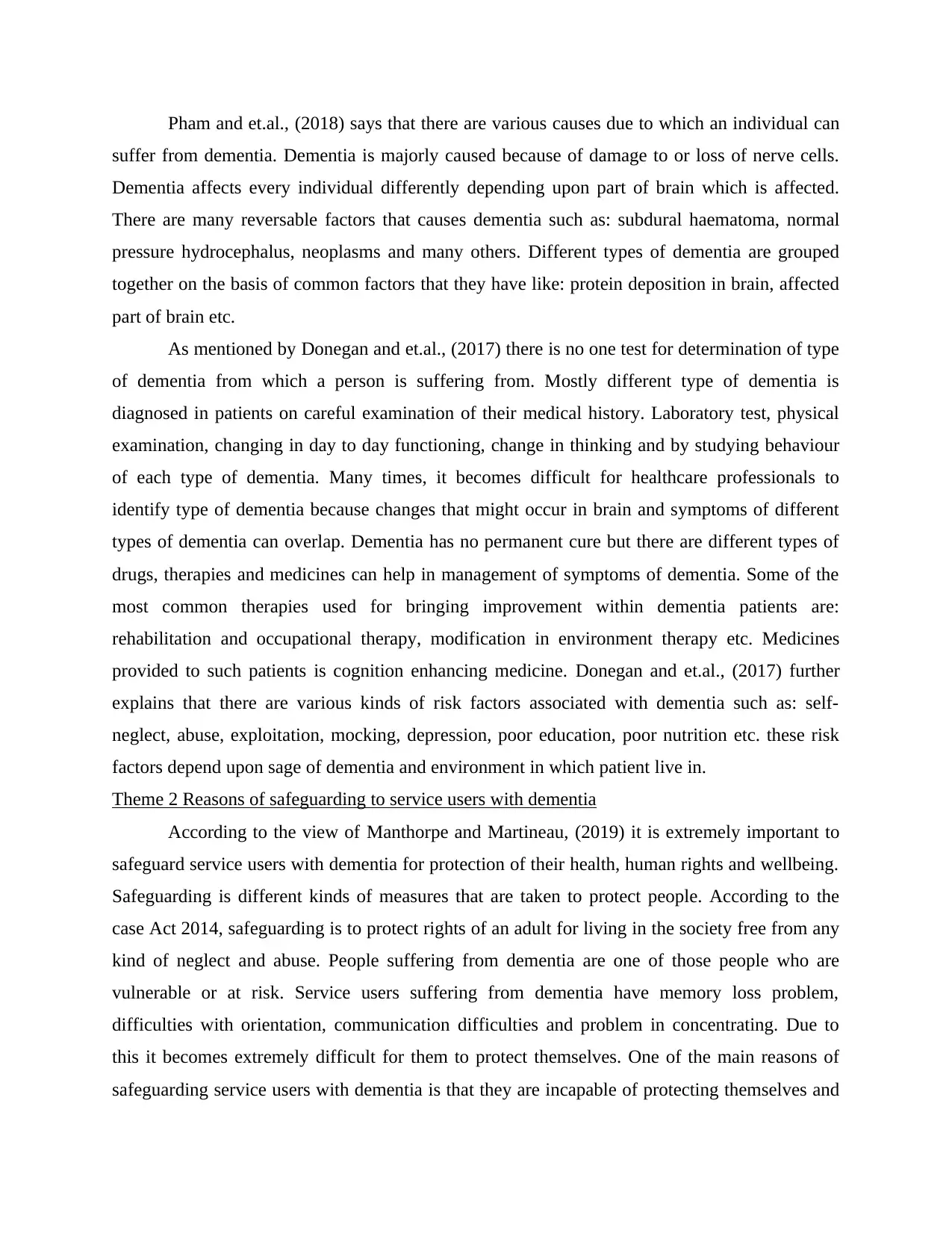
Pham and et.al., (2018) says that there are various causes due to which an individual can
suffer from dementia. Dementia is majorly caused because of damage to or loss of nerve cells.
Dementia affects every individual differently depending upon part of brain which is affected.
There are many reversable factors that causes dementia such as: subdural haematoma, normal
pressure hydrocephalus, neoplasms and many others. Different types of dementia are grouped
together on the basis of common factors that they have like: protein deposition in brain, affected
part of brain etc.
As mentioned by Donegan and et.al., (2017) there is no one test for determination of type
of dementia from which a person is suffering from. Mostly different type of dementia is
diagnosed in patients on careful examination of their medical history. Laboratory test, physical
examination, changing in day to day functioning, change in thinking and by studying behaviour
of each type of dementia. Many times, it becomes difficult for healthcare professionals to
identify type of dementia because changes that might occur in brain and symptoms of different
types of dementia can overlap. Dementia has no permanent cure but there are different types of
drugs, therapies and medicines can help in management of symptoms of dementia. Some of the
most common therapies used for bringing improvement within dementia patients are:
rehabilitation and occupational therapy, modification in environment therapy etc. Medicines
provided to such patients is cognition enhancing medicine. Donegan and et.al., (2017) further
explains that there are various kinds of risk factors associated with dementia such as: self-
neglect, abuse, exploitation, mocking, depression, poor education, poor nutrition etc. these risk
factors depend upon sage of dementia and environment in which patient live in.
Theme 2 Reasons of safeguarding to service users with dementia
According to the view of Manthorpe and Martineau, (2019) it is extremely important to
safeguard service users with dementia for protection of their health, human rights and wellbeing.
Safeguarding is different kinds of measures that are taken to protect people. According to the
case Act 2014, safeguarding is to protect rights of an adult for living in the society free from any
kind of neglect and abuse. People suffering from dementia are one of those people who are
vulnerable or at risk. Service users suffering from dementia have memory loss problem,
difficulties with orientation, communication difficulties and problem in concentrating. Due to
this it becomes extremely difficult for them to protect themselves. One of the main reasons of
safeguarding service users with dementia is that they are incapable of protecting themselves and
suffer from dementia. Dementia is majorly caused because of damage to or loss of nerve cells.
Dementia affects every individual differently depending upon part of brain which is affected.
There are many reversable factors that causes dementia such as: subdural haematoma, normal
pressure hydrocephalus, neoplasms and many others. Different types of dementia are grouped
together on the basis of common factors that they have like: protein deposition in brain, affected
part of brain etc.
As mentioned by Donegan and et.al., (2017) there is no one test for determination of type
of dementia from which a person is suffering from. Mostly different type of dementia is
diagnosed in patients on careful examination of their medical history. Laboratory test, physical
examination, changing in day to day functioning, change in thinking and by studying behaviour
of each type of dementia. Many times, it becomes difficult for healthcare professionals to
identify type of dementia because changes that might occur in brain and symptoms of different
types of dementia can overlap. Dementia has no permanent cure but there are different types of
drugs, therapies and medicines can help in management of symptoms of dementia. Some of the
most common therapies used for bringing improvement within dementia patients are:
rehabilitation and occupational therapy, modification in environment therapy etc. Medicines
provided to such patients is cognition enhancing medicine. Donegan and et.al., (2017) further
explains that there are various kinds of risk factors associated with dementia such as: self-
neglect, abuse, exploitation, mocking, depression, poor education, poor nutrition etc. these risk
factors depend upon sage of dementia and environment in which patient live in.
Theme 2 Reasons of safeguarding to service users with dementia
According to the view of Manthorpe and Martineau, (2019) it is extremely important to
safeguard service users with dementia for protection of their health, human rights and wellbeing.
Safeguarding is different kinds of measures that are taken to protect people. According to the
case Act 2014, safeguarding is to protect rights of an adult for living in the society free from any
kind of neglect and abuse. People suffering from dementia are one of those people who are
vulnerable or at risk. Service users suffering from dementia have memory loss problem,
difficulties with orientation, communication difficulties and problem in concentrating. Due to
this it becomes extremely difficult for them to protect themselves. One of the main reasons of
safeguarding service users with dementia is that they are incapable of protecting themselves and
Paraphrase This Document
Need a fresh take? Get an instant paraphrase of this document with our AI Paraphraser
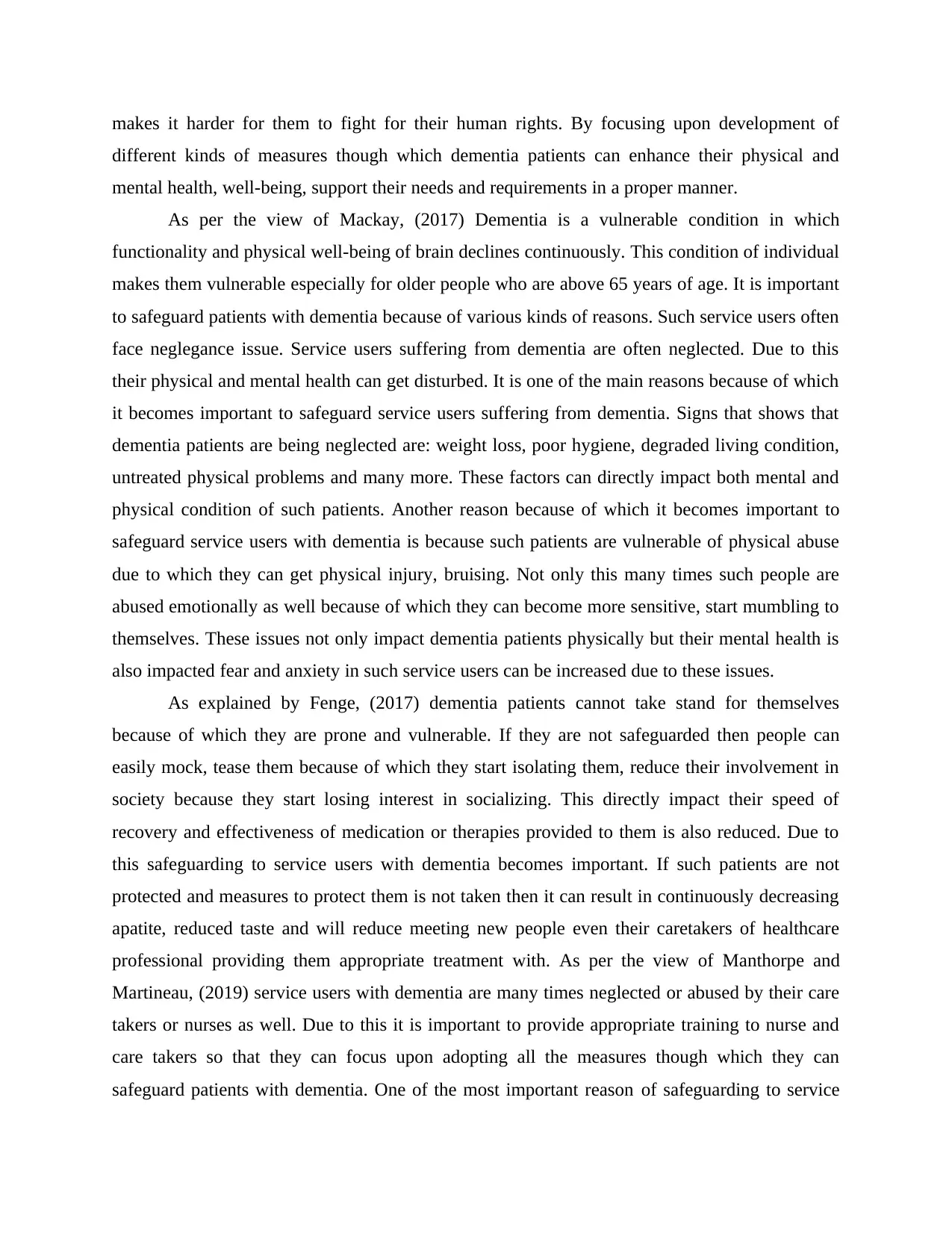
makes it harder for them to fight for their human rights. By focusing upon development of
different kinds of measures though which dementia patients can enhance their physical and
mental health, well-being, support their needs and requirements in a proper manner.
As per the view of Mackay, (2017) Dementia is a vulnerable condition in which
functionality and physical well-being of brain declines continuously. This condition of individual
makes them vulnerable especially for older people who are above 65 years of age. It is important
to safeguard patients with dementia because of various kinds of reasons. Such service users often
face neglegance issue. Service users suffering from dementia are often neglected. Due to this
their physical and mental health can get disturbed. It is one of the main reasons because of which
it becomes important to safeguard service users suffering from dementia. Signs that shows that
dementia patients are being neglected are: weight loss, poor hygiene, degraded living condition,
untreated physical problems and many more. These factors can directly impact both mental and
physical condition of such patients. Another reason because of which it becomes important to
safeguard service users with dementia is because such patients are vulnerable of physical abuse
due to which they can get physical injury, bruising. Not only this many times such people are
abused emotionally as well because of which they can become more sensitive, start mumbling to
themselves. These issues not only impact dementia patients physically but their mental health is
also impacted fear and anxiety in such service users can be increased due to these issues.
As explained by Fenge, (2017) dementia patients cannot take stand for themselves
because of which they are prone and vulnerable. If they are not safeguarded then people can
easily mock, tease them because of which they start isolating them, reduce their involvement in
society because they start losing interest in socializing. This directly impact their speed of
recovery and effectiveness of medication or therapies provided to them is also reduced. Due to
this safeguarding to service users with dementia becomes important. If such patients are not
protected and measures to protect them is not taken then it can result in continuously decreasing
apatite, reduced taste and will reduce meeting new people even their caretakers of healthcare
professional providing them appropriate treatment with. As per the view of Manthorpe and
Martineau, (2019) service users with dementia are many times neglected or abused by their care
takers or nurses as well. Due to this it is important to provide appropriate training to nurse and
care takers so that they can focus upon adopting all the measures though which they can
safeguard patients with dementia. One of the most important reason of safeguarding to service
different kinds of measures though which dementia patients can enhance their physical and
mental health, well-being, support their needs and requirements in a proper manner.
As per the view of Mackay, (2017) Dementia is a vulnerable condition in which
functionality and physical well-being of brain declines continuously. This condition of individual
makes them vulnerable especially for older people who are above 65 years of age. It is important
to safeguard patients with dementia because of various kinds of reasons. Such service users often
face neglegance issue. Service users suffering from dementia are often neglected. Due to this
their physical and mental health can get disturbed. It is one of the main reasons because of which
it becomes important to safeguard service users suffering from dementia. Signs that shows that
dementia patients are being neglected are: weight loss, poor hygiene, degraded living condition,
untreated physical problems and many more. These factors can directly impact both mental and
physical condition of such patients. Another reason because of which it becomes important to
safeguard service users with dementia is because such patients are vulnerable of physical abuse
due to which they can get physical injury, bruising. Not only this many times such people are
abused emotionally as well because of which they can become more sensitive, start mumbling to
themselves. These issues not only impact dementia patients physically but their mental health is
also impacted fear and anxiety in such service users can be increased due to these issues.
As explained by Fenge, (2017) dementia patients cannot take stand for themselves
because of which they are prone and vulnerable. If they are not safeguarded then people can
easily mock, tease them because of which they start isolating them, reduce their involvement in
society because they start losing interest in socializing. This directly impact their speed of
recovery and effectiveness of medication or therapies provided to them is also reduced. Due to
this safeguarding to service users with dementia becomes important. If such patients are not
protected and measures to protect them is not taken then it can result in continuously decreasing
apatite, reduced taste and will reduce meeting new people even their caretakers of healthcare
professional providing them appropriate treatment with. As per the view of Manthorpe and
Martineau, (2019) service users with dementia are many times neglected or abused by their care
takers or nurses as well. Due to this it is important to provide appropriate training to nurse and
care takers so that they can focus upon adopting all the measures though which they can
safeguard patients with dementia. One of the most important reason of safeguarding to service
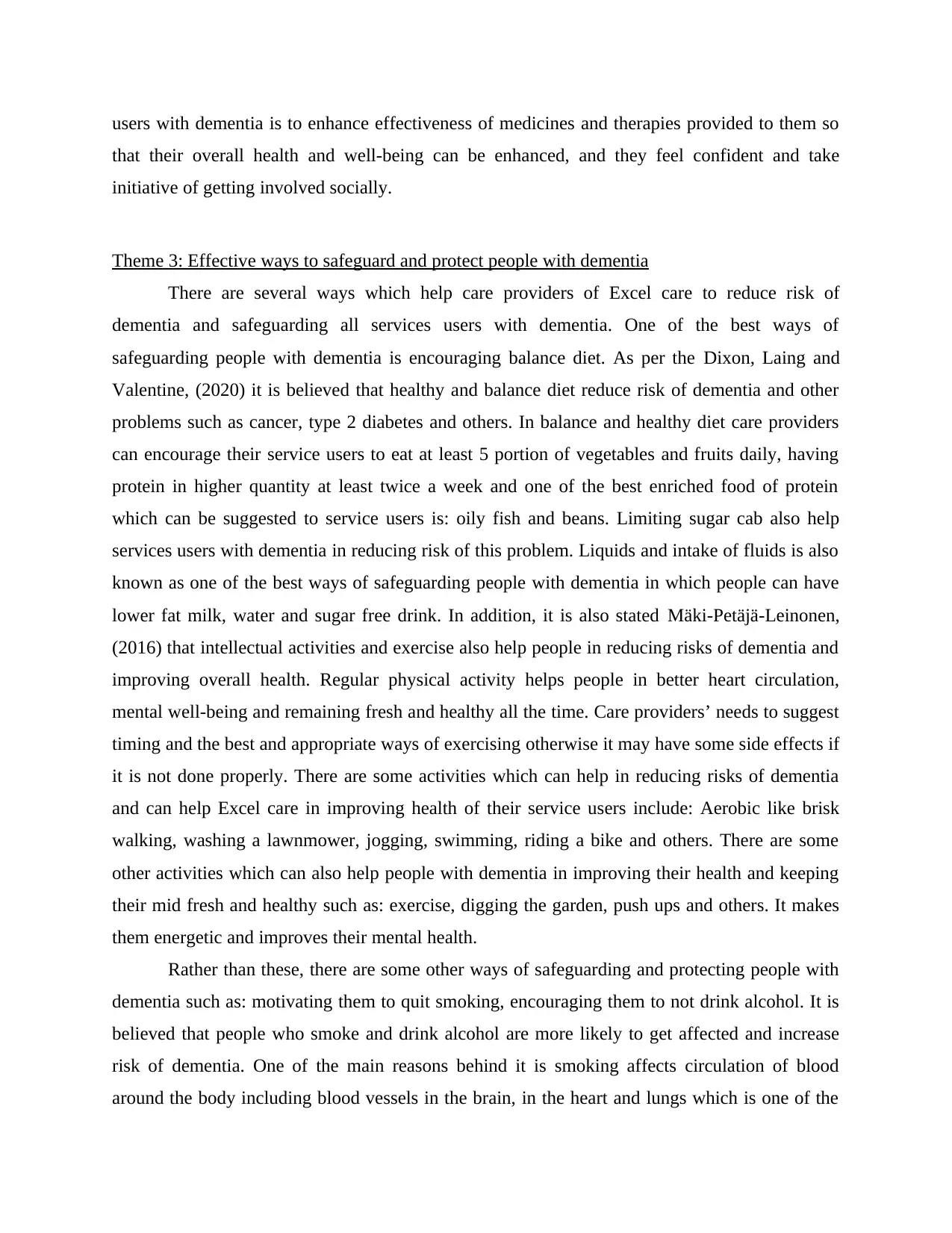
users with dementia is to enhance effectiveness of medicines and therapies provided to them so
that their overall health and well-being can be enhanced, and they feel confident and take
initiative of getting involved socially.
Theme 3: Effective ways to safeguard and protect people with dementia
There are several ways which help care providers of Excel care to reduce risk of
dementia and safeguarding all services users with dementia. One of the best ways of
safeguarding people with dementia is encouraging balance diet. As per the Dixon, Laing and
Valentine, (2020) it is believed that healthy and balance diet reduce risk of dementia and other
problems such as cancer, type 2 diabetes and others. In balance and healthy diet care providers
can encourage their service users to eat at least 5 portion of vegetables and fruits daily, having
protein in higher quantity at least twice a week and one of the best enriched food of protein
which can be suggested to service users is: oily fish and beans. Limiting sugar cab also help
services users with dementia in reducing risk of this problem. Liquids and intake of fluids is also
known as one of the best ways of safeguarding people with dementia in which people can have
lower fat milk, water and sugar free drink. In addition, it is also stated Mäki-Petäjä-Leinonen,
(2016) that intellectual activities and exercise also help people in reducing risks of dementia and
improving overall health. Regular physical activity helps people in better heart circulation,
mental well-being and remaining fresh and healthy all the time. Care providers’ needs to suggest
timing and the best and appropriate ways of exercising otherwise it may have some side effects if
it is not done properly. There are some activities which can help in reducing risks of dementia
and can help Excel care in improving health of their service users include: Aerobic like brisk
walking, washing a lawnmower, jogging, swimming, riding a bike and others. There are some
other activities which can also help people with dementia in improving their health and keeping
their mid fresh and healthy such as: exercise, digging the garden, push ups and others. It makes
them energetic and improves their mental health.
Rather than these, there are some other ways of safeguarding and protecting people with
dementia such as: motivating them to quit smoking, encouraging them to not drink alcohol. It is
believed that people who smoke and drink alcohol are more likely to get affected and increase
risk of dementia. One of the main reasons behind it is smoking affects circulation of blood
around the body including blood vessels in the brain, in the heart and lungs which is one of the
that their overall health and well-being can be enhanced, and they feel confident and take
initiative of getting involved socially.
Theme 3: Effective ways to safeguard and protect people with dementia
There are several ways which help care providers of Excel care to reduce risk of
dementia and safeguarding all services users with dementia. One of the best ways of
safeguarding people with dementia is encouraging balance diet. As per the Dixon, Laing and
Valentine, (2020) it is believed that healthy and balance diet reduce risk of dementia and other
problems such as cancer, type 2 diabetes and others. In balance and healthy diet care providers
can encourage their service users to eat at least 5 portion of vegetables and fruits daily, having
protein in higher quantity at least twice a week and one of the best enriched food of protein
which can be suggested to service users is: oily fish and beans. Limiting sugar cab also help
services users with dementia in reducing risk of this problem. Liquids and intake of fluids is also
known as one of the best ways of safeguarding people with dementia in which people can have
lower fat milk, water and sugar free drink. In addition, it is also stated Mäki-Petäjä-Leinonen,
(2016) that intellectual activities and exercise also help people in reducing risks of dementia and
improving overall health. Regular physical activity helps people in better heart circulation,
mental well-being and remaining fresh and healthy all the time. Care providers’ needs to suggest
timing and the best and appropriate ways of exercising otherwise it may have some side effects if
it is not done properly. There are some activities which can help in reducing risks of dementia
and can help Excel care in improving health of their service users include: Aerobic like brisk
walking, washing a lawnmower, jogging, swimming, riding a bike and others. There are some
other activities which can also help people with dementia in improving their health and keeping
their mid fresh and healthy such as: exercise, digging the garden, push ups and others. It makes
them energetic and improves their mental health.
Rather than these, there are some other ways of safeguarding and protecting people with
dementia such as: motivating them to quit smoking, encouraging them to not drink alcohol. It is
believed that people who smoke and drink alcohol are more likely to get affected and increase
risk of dementia. One of the main reasons behind it is smoking affects circulation of blood
around the body including blood vessels in the brain, in the heart and lungs which is one of the
⊘ This is a preview!⊘
Do you want full access?
Subscribe today to unlock all pages.

Trusted by 1+ million students worldwide
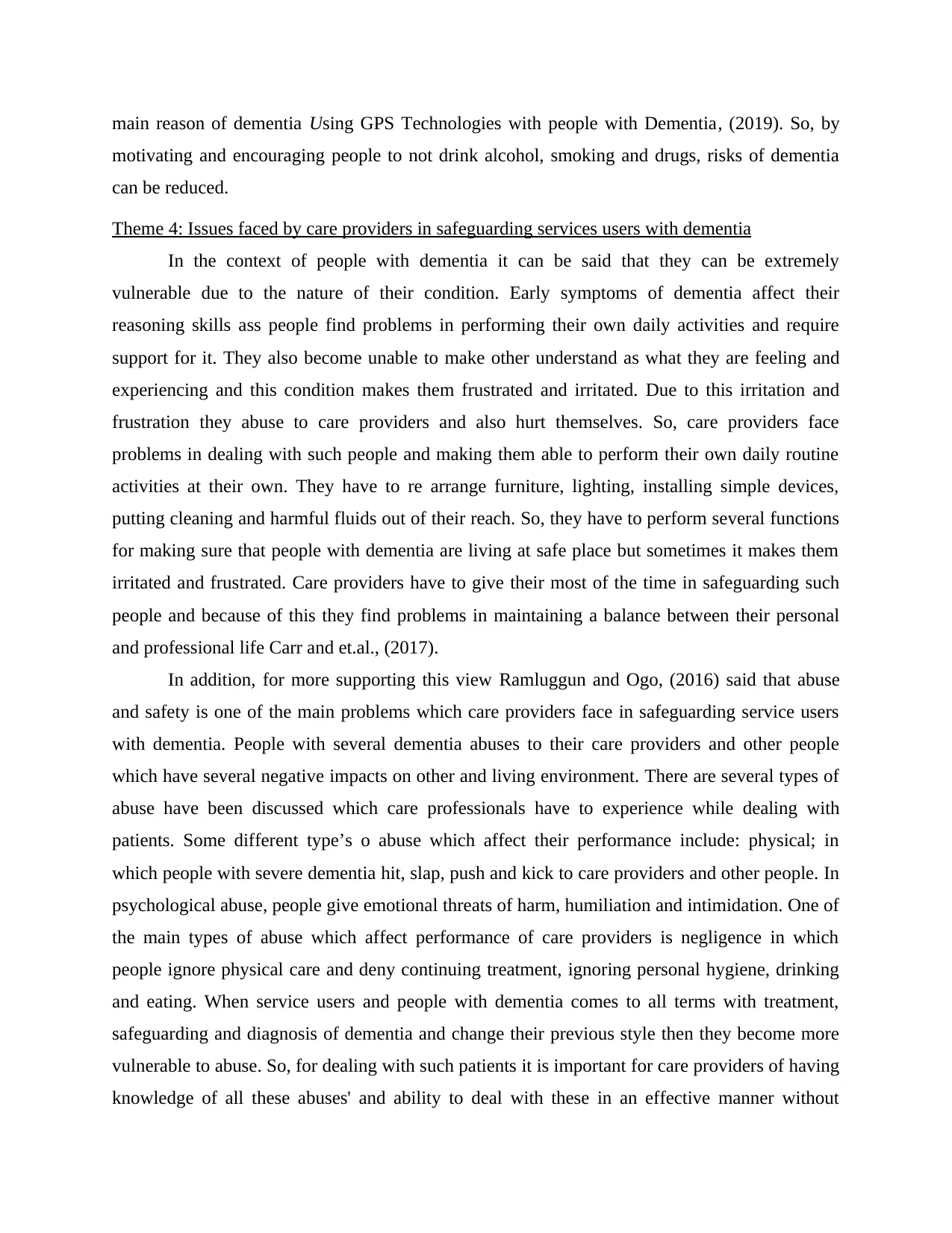
main reason of dementia Using GPS Technologies with people with Dementia, (2019). So, by
motivating and encouraging people to not drink alcohol, smoking and drugs, risks of dementia
can be reduced.
Theme 4: Issues faced by care providers in safeguarding services users with dementia
In the context of people with dementia it can be said that they can be extremely
vulnerable due to the nature of their condition. Early symptoms of dementia affect their
reasoning skills ass people find problems in performing their own daily activities and require
support for it. They also become unable to make other understand as what they are feeling and
experiencing and this condition makes them frustrated and irritated. Due to this irritation and
frustration they abuse to care providers and also hurt themselves. So, care providers face
problems in dealing with such people and making them able to perform their own daily routine
activities at their own. They have to re arrange furniture, lighting, installing simple devices,
putting cleaning and harmful fluids out of their reach. So, they have to perform several functions
for making sure that people with dementia are living at safe place but sometimes it makes them
irritated and frustrated. Care providers have to give their most of the time in safeguarding such
people and because of this they find problems in maintaining a balance between their personal
and professional life Carr and et.al., (2017).
In addition, for more supporting this view Ramluggun and Ogo, (2016) said that abuse
and safety is one of the main problems which care providers face in safeguarding service users
with dementia. People with several dementia abuses to their care providers and other people
which have several negative impacts on other and living environment. There are several types of
abuse have been discussed which care professionals have to experience while dealing with
patients. Some different type’s o abuse which affect their performance include: physical; in
which people with severe dementia hit, slap, push and kick to care providers and other people. In
psychological abuse, people give emotional threats of harm, humiliation and intimidation. One of
the main types of abuse which affect performance of care providers is negligence in which
people ignore physical care and deny continuing treatment, ignoring personal hygiene, drinking
and eating. When service users and people with dementia comes to all terms with treatment,
safeguarding and diagnosis of dementia and change their previous style then they become more
vulnerable to abuse. So, for dealing with such patients it is important for care providers of having
knowledge of all these abuses' and ability to deal with these in an effective manner without
motivating and encouraging people to not drink alcohol, smoking and drugs, risks of dementia
can be reduced.
Theme 4: Issues faced by care providers in safeguarding services users with dementia
In the context of people with dementia it can be said that they can be extremely
vulnerable due to the nature of their condition. Early symptoms of dementia affect their
reasoning skills ass people find problems in performing their own daily activities and require
support for it. They also become unable to make other understand as what they are feeling and
experiencing and this condition makes them frustrated and irritated. Due to this irritation and
frustration they abuse to care providers and also hurt themselves. So, care providers face
problems in dealing with such people and making them able to perform their own daily routine
activities at their own. They have to re arrange furniture, lighting, installing simple devices,
putting cleaning and harmful fluids out of their reach. So, they have to perform several functions
for making sure that people with dementia are living at safe place but sometimes it makes them
irritated and frustrated. Care providers have to give their most of the time in safeguarding such
people and because of this they find problems in maintaining a balance between their personal
and professional life Carr and et.al., (2017).
In addition, for more supporting this view Ramluggun and Ogo, (2016) said that abuse
and safety is one of the main problems which care providers face in safeguarding service users
with dementia. People with several dementia abuses to their care providers and other people
which have several negative impacts on other and living environment. There are several types of
abuse have been discussed which care professionals have to experience while dealing with
patients. Some different type’s o abuse which affect their performance include: physical; in
which people with severe dementia hit, slap, push and kick to care providers and other people. In
psychological abuse, people give emotional threats of harm, humiliation and intimidation. One of
the main types of abuse which affect performance of care providers is negligence in which
people ignore physical care and deny continuing treatment, ignoring personal hygiene, drinking
and eating. When service users and people with dementia comes to all terms with treatment,
safeguarding and diagnosis of dementia and change their previous style then they become more
vulnerable to abuse. So, for dealing with such patients it is important for care providers of having
knowledge of all these abuses' and ability to deal with these in an effective manner without
Paraphrase This Document
Need a fresh take? Get an instant paraphrase of this document with our AI Paraphraser
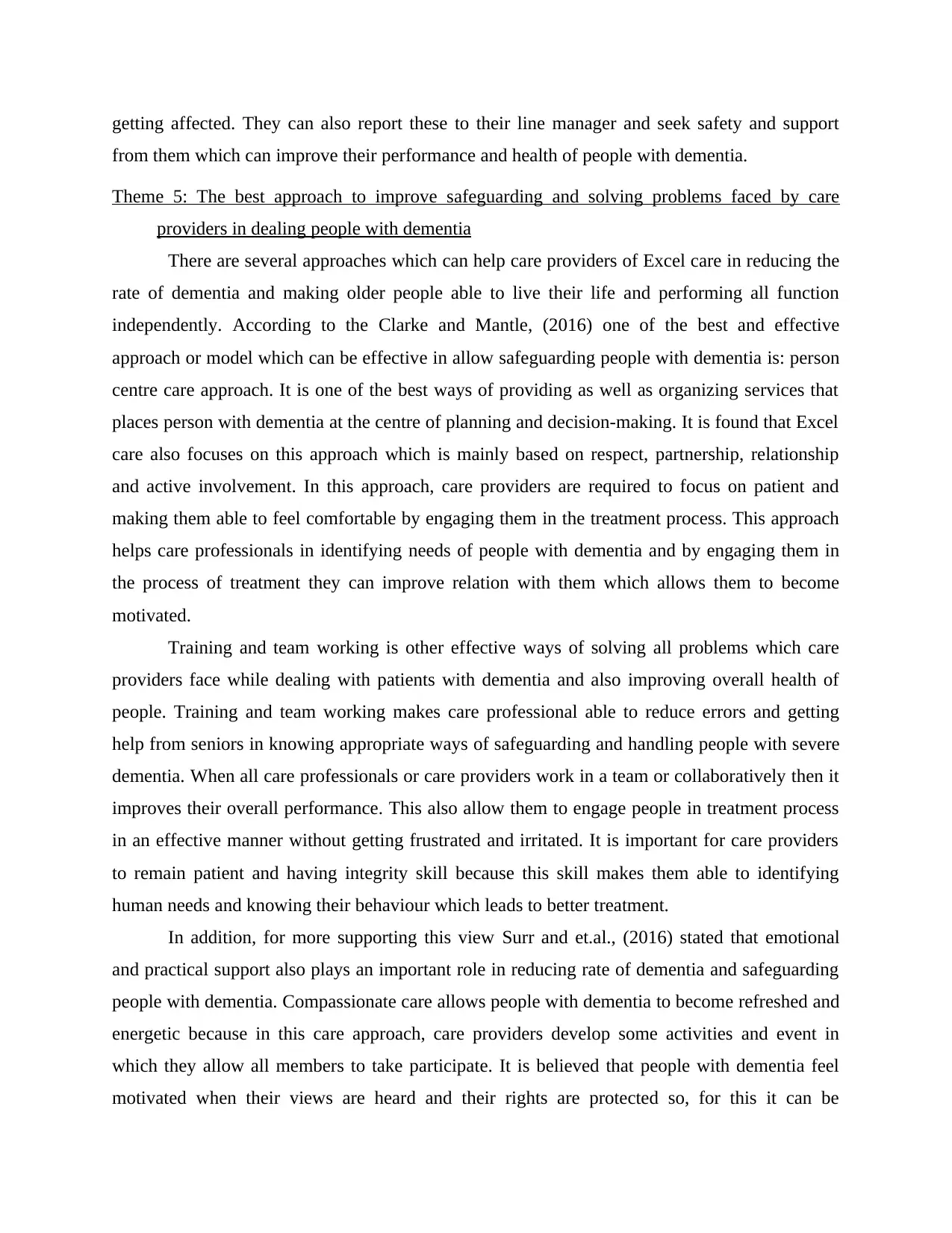
getting affected. They can also report these to their line manager and seek safety and support
from them which can improve their performance and health of people with dementia.
Theme 5: The best approach to improve safeguarding and solving problems faced by care
providers in dealing people with dementia
There are several approaches which can help care providers of Excel care in reducing the
rate of dementia and making older people able to live their life and performing all function
independently. According to the Clarke and Mantle, (2016) one of the best and effective
approach or model which can be effective in allow safeguarding people with dementia is: person
centre care approach. It is one of the best ways of providing as well as organizing services that
places person with dementia at the centre of planning and decision-making. It is found that Excel
care also focuses on this approach which is mainly based on respect, partnership, relationship
and active involvement. In this approach, care providers are required to focus on patient and
making them able to feel comfortable by engaging them in the treatment process. This approach
helps care professionals in identifying needs of people with dementia and by engaging them in
the process of treatment they can improve relation with them which allows them to become
motivated.
Training and team working is other effective ways of solving all problems which care
providers face while dealing with patients with dementia and also improving overall health of
people. Training and team working makes care professional able to reduce errors and getting
help from seniors in knowing appropriate ways of safeguarding and handling people with severe
dementia. When all care professionals or care providers work in a team or collaboratively then it
improves their overall performance. This also allow them to engage people in treatment process
in an effective manner without getting frustrated and irritated. It is important for care providers
to remain patient and having integrity skill because this skill makes them able to identifying
human needs and knowing their behaviour which leads to better treatment.
In addition, for more supporting this view Surr and et.al., (2016) stated that emotional
and practical support also plays an important role in reducing rate of dementia and safeguarding
people with dementia. Compassionate care allows people with dementia to become refreshed and
energetic because in this care approach, care providers develop some activities and event in
which they allow all members to take participate. It is believed that people with dementia feel
motivated when their views are heard and their rights are protected so, for this it can be
from them which can improve their performance and health of people with dementia.
Theme 5: The best approach to improve safeguarding and solving problems faced by care
providers in dealing people with dementia
There are several approaches which can help care providers of Excel care in reducing the
rate of dementia and making older people able to live their life and performing all function
independently. According to the Clarke and Mantle, (2016) one of the best and effective
approach or model which can be effective in allow safeguarding people with dementia is: person
centre care approach. It is one of the best ways of providing as well as organizing services that
places person with dementia at the centre of planning and decision-making. It is found that Excel
care also focuses on this approach which is mainly based on respect, partnership, relationship
and active involvement. In this approach, care providers are required to focus on patient and
making them able to feel comfortable by engaging them in the treatment process. This approach
helps care professionals in identifying needs of people with dementia and by engaging them in
the process of treatment they can improve relation with them which allows them to become
motivated.
Training and team working is other effective ways of solving all problems which care
providers face while dealing with patients with dementia and also improving overall health of
people. Training and team working makes care professional able to reduce errors and getting
help from seniors in knowing appropriate ways of safeguarding and handling people with severe
dementia. When all care professionals or care providers work in a team or collaboratively then it
improves their overall performance. This also allow them to engage people in treatment process
in an effective manner without getting frustrated and irritated. It is important for care providers
to remain patient and having integrity skill because this skill makes them able to identifying
human needs and knowing their behaviour which leads to better treatment.
In addition, for more supporting this view Surr and et.al., (2016) stated that emotional
and practical support also plays an important role in reducing rate of dementia and safeguarding
people with dementia. Compassionate care allows people with dementia to become refreshed and
energetic because in this care approach, care providers develop some activities and event in
which they allow all members to take participate. It is believed that people with dementia feel
motivated when their views are heard and their rights are protected so, for this it can be

recommended that care providers require taking feedbacks and engaging them in ongoing family
involvement approach for promoting access to advocacy. There are several other ways of
interacting and engaging people with severe dementia such as: reassuring words, gentle touch,
experiencing happiness, true connection and quite encouragement.
involvement approach for promoting access to advocacy. There are several other ways of
interacting and engaging people with severe dementia such as: reassuring words, gentle touch,
experiencing happiness, true connection and quite encouragement.
⊘ This is a preview!⊘
Do you want full access?
Subscribe today to unlock all pages.

Trusted by 1+ million students worldwide
1 out of 35
Related Documents
Your All-in-One AI-Powered Toolkit for Academic Success.
+13062052269
info@desklib.com
Available 24*7 on WhatsApp / Email
![[object Object]](/_next/static/media/star-bottom.7253800d.svg)
Unlock your academic potential
Copyright © 2020–2025 A2Z Services. All Rights Reserved. Developed and managed by ZUCOL.





